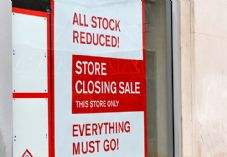UK DIY News
Barclays Data Shows DIY Spending Dropped In April

- Grocery spending saw its smallest increase since June 2022, with a record 73 per cent of Brits trying to cut the cost of their weekly shop
- The cold and wet weather hampered retail, which saw its first decline since September 2022, yet pharmacy, health & beauty stores continued to benefit from the ‘lipstick effect’
- The Easter weekend and holiday bookings boosted pubs, travel and entertainment, with digital content & subscriptions buoyed by releases such as ‘Baby Reindeer’ and ‘Ripley’
- Spending on housing costs grew 3.6 per cent, ending a three-month slowdown, while leaseholders voice concerns over ground rent and service charges
- The Barclays Consumer Spend report combines hundreds of millions of customer transactions with consumer research to provide an in-depth view of UK spending
Consumer card spending slowed to 1.6 per cent growth in April, down from 1.9 per cent in both March and February, and below the latest CPIH* inflation rate of 3.8 per cent. While consumer confidence in household finances rose to its highest level in over three years, a slowdown in food price inflation and cutbacks on food and drink led to a decline for restaurants and the smallest uplift in supermarket spending since June 2022. Meanwhile, cold and wet weather dampened retail sales, but Easter and summer holiday bookings boosted pubs, entertainment and international travel.
Brits cut back on spending on eating and drinking out in April, with restaurants once again experiencing a downturn, falling further into decline at -13 .1 per cent (in comparison to -12.6 per cent last month). Meanwhile, growth in spending on takeaways and fast food remained flat, at 3.0 per cent.
This comes as half (49 per cent) of Brits say they are concerned about how much they spend on food and drink, with the same proportion making the effort to cut back on discretionary spending (49 per cent). Of this group, the majority are spending less on dining out and ordering takeaways, both at 54 per cent respectively. One in four (24 per cent) say they are cutting back on coffee or drink subscriptions.
In an effort to control spending, 58 per cent of Brits have openly discussed aspects of their finances with loved ones – otherwise known as ‘loud budgeting’ – with consumers most often talking about their goal to cut back on takeaways (29 per cent) and restaurants (25 per cent).
Supermarket savings surge
Despite falling food price inflation (down from 5.0 per cent to 4.0 per cent), a record 73 per cent of Brits are actively looking for ways to reduce the cost of their weekly shop – the highest percentage since Barclays started tracking in January 2023 – as grocery spending growth reached its lowest level (1.0 per cent) since June 2022 (-0.8 per cent). More broadly, spending on essential items grew just 1.7 per cent year-on-year in April, the lowest rise so far this year.
Two in five (44 per cent) supermarket savers are avoiding impulse buys at the checkout, while 37 per cent are stockpiling their go-to products when they are on offer, and three in 10 (29 per cent) are batch cooking to save money. Meanwhile, more shoppers have noticed supermarket products running out of stock, at 60 per cent (vs. 50 per cent last month), with fruit and vegetables, and eggs and dairy emerging as the most cited items impacted.
Consumer confidence climbs
Despite the overall slowdown in spending growth, Brits’ confidence in their ability to manage their household finances reached its highest level since November 2021, at 71 per cent. Consumers’ confidence in their ability to live within their means also improved, increasing by two percentage points month-on-month to 74 per cent. Confidence in their ability to spend more on non-essential items reached 56 per cent, up from 55 per cent in March.
Wet and windy April puts pressure on retailers
Overall retail spending contracted by -0.1 per cent, marking the first month of decline for the category since September 2022, as in-store shopping was hampered by April’s cold snap. Face-to-face retail (excluding groceries) fell by -2.5 per cent, and clothing sales dropped by -2.1 per cent. However, pharmacy, health & beauty retailers bucked this trend, seeing a 4.9 per cent increase, boosted by a number of macro factors, such as the “lipstick effect”, the wellness boom and viral makeup and skincare videos.
Surge in subscription spending
The launch of new TV series such as ‘Baby Reindeer’, ‘Ripley’ and ‘Fallout’, along with higher subscription fees and stricter rules around password sharing introduced by some streaming companies, led to a noticeable increase in spending on digital content and subscriptions, up 10.6 per cent in April, compared to 7.7 per cent in March.
Meanwhile, more than six in 10 (61 per cent) consumers say they are concerned about the rising costs of digital content and subscriptions, likely in response to recent announcements of price increases across the category.
Fun-seekers prepared to dodge dynamic pricing
Spending on entertainment grew 3.2 per cent last month, on par with March’s growth (3.1 per cent), as families spent on leisure during the half-term break.
This rise in entertainment spending comes as 56 per cent of Brits say they have noticed that tickets for events, attractions and museums have increased in price over the past year, with a similar proportion (57 per cent) saying they are concerned about this trend.
A quarter (25 per cent) of Brits said that if an attraction had ‘dynamic pricing’ in place – where ticket prices change in response to factors such as weather and demand – they would only visit at off-peak times. A similar proportion (23 per cent) would seek out free alternative attractions, such as parks or certain museums, if dynamic pricing is in place.
Holidays abroad outshine staycations
Travel agents had another positive month, once again rising 7.1 per cent, as holidaymakers booked summer getaways. However, hotels, resorts and accommodation saw their first decline (-0.7 per cent) since May 2023. A third (32 per cent) of consumers say they’re prioritising holidays abroad over staycations this year, with almost two fifths (39 per cent) of this group hoping to escape the wet and cold weather in search of some sunshine.
Housing costs accelerate while services charges sting
UK spending on rental and mortgage payments rose 3.6 per cent year-on-year in April*, ending the three-month slowdown in spending witnessed from January to March. Reassuringly, growth remains below February’s figure (4.7 per cent), and also below the 12-month average (6.5 per cent), indicating that costs are still heading in the right direction over the longer term.
Service charges and ground rent increases have become an unexpected burden for many affected homeowners, as just over a third of payers (37 per cent) regard these costs as affordable. Meanwhile, on top of the high price tag, most leaseholders feel blindsided by the charges, as just a third (33 per cent) recall being made aware of the costs before purchasing their property, and only 23 per cent saying they understood the rate at which the costs would increase.
On top of affordability, level of service is a growing issue as leaseholders see few improvements to their properties despite the premium – only 13 per cent feel they get good value for money, and even fewer (10 per cent) believe the money from their fees is spent effectively. Nearly a fifth (17 per cent) of those paying service/ground rent fees are also concerned they won’t be able to sell their homes because of the charges.
DIY down as consumers cut costs
Brits are trying to cut down on their household costs, with 40 per cent saying they will not spend on their home or garden ahead of the summer. Many are opting to postpone renovations or home improvements, as consumer card spending on household categories such as homewares, electronics and DIY fell by -4.1 per cent in April.
Karen Johnson, Head of Retail at Barclays, said: “Retailers were hopeful that discretionary spending would bounce back by mid-year, buoyed by falling inflation and the prospect of better weather. While improving consumer confidence offers a ray of hope for the retail and hospitality industries as the summer season approaches, many retailers have adjusted their expectations, anticipating no real recovery until the autumn.”
Mark Arnold, Head of Savings and Mortgages at Barclays, said: “Consumers and lenders alike are anticipating a drop in interest rates this year, but optimism is understandably tentative as the market is still feeling the effects of last year’s volatility. Our data shows that Brits are still facing higher rent and mortgage payments, although costs are still slowing down over the longer term.”
Jack Meaning, Chief UK Economist at Barclays, said: “With inflation expected to have dropped back to 2 per cent in April, and with many anticipating a boost from the National Living Wage increase, it is encouraging to see consumer confidence picking up. Given the long squeeze consumers have faced, it may take time for this to translate into stronger discretionary expenditure, but easing interest rates in the second half of this year should spur consumers’ confidence and spending.”
Overall growth figures
Spend Growth | Transaction Growth | |
Essential | 1.7% | 1.3% |
Non Essential | 1.5% | 2.9% |
|
| |
OVERALL | 1.6% | 2.3% |
Retail | -0.1% | 1.7% |
Clothing | -2.1% | 2.1% |
Grocery | 1.0% | 1.8% |
| 1.1% | 1.4% |
| 0.4% | 4.0% |
Household | -4.1% | 3.2% |
| -6.6% | -1.0% |
| 0.8% | 9.0% |
| -4.0% | 4.9% |
| -4.7% | -1.3% |
General Retailers | 2.4% | 2.1% |
| 5.3% | 6.3% |
| -1.4% | 1.2% |
| -8.6% | -11.3% |
Specialist Retailers | -1.0% | -1.2% |
| 4.9% | 1.9% |
| -8.1% | -8.2% |
| -2.4% | -2.9% |
Hospitality & Leisure | 4.1% | 3.3% |
Digital Content & Subscription | 10.6% | 7.4% |
Eating & Drinking | 2.8% | 0.9% |
| -13.1% | -14.2% |
| 3.9% | 2.7% |
| 3.0% | 0.5% |
| 5.8% | 1.9% |
Entertainment | 3.2% | 5.7% |
Hotels, Resorts & Accommodation | -0.7% | -2.9% |
Travel | 5.8% | 6.5% |
| 7.1% | 14.4% |
| 6.2% | 9.2% |
| -1.4% | 1.8% |
| 9.1% | 16.3% |
Other | 2.4% | 2.0% |
Fuel | -4.8% | -2.6% |
Motoring | -2.5% | 5.5% |
Other Services | 9.3% | 6.4% |
Insperiences | 5.0% | 3.3% |
|
|
|
Online | 3.4% | 6.0% |
Face-to-Face | 0.1% | 0.8% |
Source : Barclays
Insight provides a host of information I need on many of our company’s largest customers. I use this information regularly with my team, both at a local level as well as with our other international operations. It’s extremely useful when sharing market intelligence information with our corporate office.











































